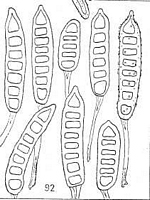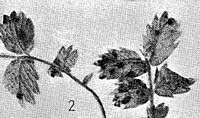|
 Phragmidium novae-zelandiae Phragmidium novae-zelandiae
BiostatusPresent in region - Indigenous. Endemic
Images (click to enlarge)
Caption: FIG. 92. Phragmidium novae-zelandiae G.H. Cunn. Teleutospores from Acaena novae-zelandiae T. Kirk. | 
Caption: FIG. 2. Phragmidium novae-zelandiae G.H. Cunn. Teleutosori from Acaena novae-zelandiae T. Kirk. |
Article: Cunningham, G.H. (1924). The Uredinales, or rust-fungi, of New Zealand: supplement to Part 1; and Part 2. Transactions and Proceedings of the New Zealand Institute 55: 1-58 Wellington:.
Description: 0. Spermogones similar to Phr. Acaenae.
I. Caeomata similar to Phr. Acaenae.
III. Teleutosori hypophyllous, sparse, elliptical, up to 3 mm long, pulvinate, pulverulent, the
spores becoming agglutinated into compact masses, dull greyish-black, naked, with very
many spores in each sorus. Spores 4-8-celled, commonly 6-7, oblong-cylindrical, 65-118 X
18-24 mmm.; apex acuminate, seldom rounded, not or slightly thickened, drawn into a long
papilla, continuous with the upper cell-wall, tinted, hyaline at the tip, up to 8 mmm. long,
base rounded or slightly attenuate, spore slightly narrowed above and below; not constricted
at the septa; wall sepia-coloured, 4-6 mmm. thick, coarsely and densely warted, warts hyaline
and more numerous apically; pedicel persistent, continuous with the spore, hyaline below,
tinted above, up to 100 mmm. long, 4-6 mmm. thick, not or slightly inflated basally, lower
half minutely and densely verruculose, germ-pores 2-4 in each cell, conspicuous.
Notes: The host is endemic and is not uncommon throughout. (Cheeseman, 1906, p. 131.)
This rust is characterized by the large size of the teleutospores, large number of cells, dark
and thick wall, and acuminate apex. The pedicels are more slender than in our other species,
and are not swollen at the base. The large number of teleutospores in the sorus, and the
manner in which they are compacted together, serve to separate this from any other species
that may be present on the same plant.
Article: Dingley, J.M. (1969). Records of plant diseases in New Zealand. New Zealand Department of Scientific and Industrial Research, Bulletin 192: 298 p. Wellington:.
Notes: Both rust and host plant [Acaena novaezelandiae] are endemic to New Zealand. It is common
throughout the country.
|